| The ancestors of the Hopi lived in what is now northern Arizona more than two thousand years ago.
By the twelfth century, several family groupshad settled on Black Mesa around the village of Oraibi,
making the place one of the oldest continuously inhabited places in North America. Most of today's
Hopi live in the same area.
The Hopi, isolated on their high mesas, were little affected by the Spanish and Mexican rule of the area, which started in the late seventeenth century. In 1848, the area was ceded to the United States by Mexico at the end of the Mexican War. The US government laid out the Hopi reservation in 1882. The pottery tradition of the south western Indians goes back several thousand years. During the nineteenth century, with the coming of greater trade and influence from whites, Hopi manufacture of pottery declined. In the early twentieth century, as interest in Indian art developed, the women in several Hopi families revived the ancient tradition. In particular, one Hopi woman, Nampeyo (c1860 - 1942) began to produce pottery in the traditional manner, decorated with designs from the ancient culture. She and her husband had worked with the archeologists at the Sikyatki ruins and many of her designs reflected the decorations of pottery found at this site. She, along with other women, passed the tradition on to their descendants. Most of today's Hopi artists can trace their lineage to one or more of these potters. Hopi pots are highly sought after by collectors as art objects. While most are produced for outside sale, the Hopi still produce some pots for ceremonial and everyday use. A Hopi pot is made of clay found in the local area. The body is hand-formed by the coil method; no potter's wheels are used. After the shape is air dried and scraped with stones, it is covered with a thin wash of clay, called a slip, before the final polishing and painting. After painting, the pot is fired in an oven heated by burning cakes of dung. |
.
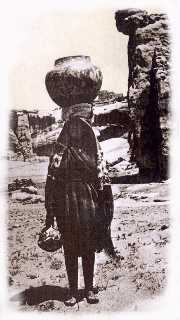 |
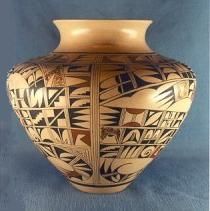 |
Grand Prix NORDIA 2001 Pot by Kathleen Collateta. Kathleen is a fifth generation descendant of Nampeyo. She currently lives in the Jemez pueblo in New Mexico. Like most of her work, this pot shows the traditional Sikyatki decorations. This award is given to the best exhibit in the Championship Class. |
 |
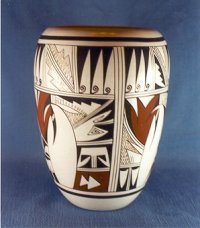 |
Grand Prix Nordique NORDIA 2001
Pot by Joy Navasie. Joy was born about 1919 and is one of the most senior potters working today. She comes from a very famous line of potters. Her mother, also very distinguished potter, was known as "Frogwoman". After her mother's death, Joy took the name and began to sign her pots with apainted frog as her mother had done. The style of this pot is called Walpipolychrome on a white slip. This award is given to the best Nordic exhibit. This award is sponsored by WESTPEX, the Association for Western Philatelic Exhibitions, Inc., San Francisco, CA. |
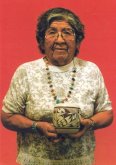 |
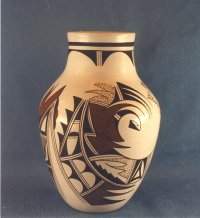 |
Grand Prix International NORDIA 2001 Pot by Marianne Navasie Marianne is the daughter of Joy Navasie. Marianne's work is very much like her mother's, in a similar Walpi polychrome style. She signs her pots with a frog and a tadpole. This award is given to the best non-Nordic exhibit. This award is sponsored by the |
![]()